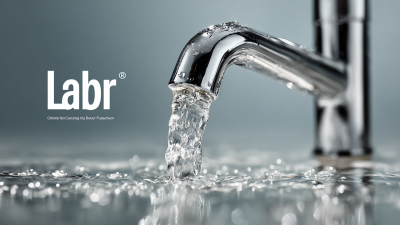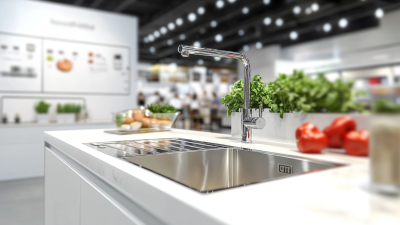In the realm of scientific research and experimentation, the importance of selecting the right laboratory faucet cannot be overstated. A laboratory faucet serves as a crucial interface between researchers and the various fluids essential to their work, whether it be water, chemicals, or gases. The choice of laboratory faucet can significantly influence the efficiency, safety, and overall functionality of any laboratory environment. This guide aims to revolutionize the way you approach the selection process, providing essential insights and practical tips on how to choose the perfect laboratory faucet for your specific needs.

From understanding the different types available to considering installation and maintenance factors, our comprehensive exploration will equip you with the knowledge needed to make informed decisions, ultimately enhancing your research capabilities and ensuring a safe working atmosphere. Join us as we delve into the key considerations that will transform your laboratory experience.
In modern research facilities, the significance of laboratory faucets cannot be overstated. These essential fixtures are not only vital for everyday tasks such as washing, mixing solutions, and conducting experiments but also play a crucial role in ensuring safety and compliance with health regulations. A well-designed laboratory faucet can enhance workflow efficiency, minimize cross-contamination, and provide easy access to running water under various conditions.
Tips for Choosing the Right Laboratory Faucet:
When selecting a laboratory faucet, consider the specific needs of your research activities. Look for faucets with ergonomic design and easy-to-use handles to promote comfort during prolonged use. Additionally, opt for materials that resist corrosion and are easy to clean to maintain hygiene standards in the lab.
Another important factor is the type of water control mechanism. Touchless faucets can minimize the risk of contamination and improve convenience, especially when working with hazardous materials. Make sure to assess the compatibility of the faucet with existing lab infrastructure to ensure seamless installation and operation.
When selecting the perfect laboratory faucet, several key features should be prioritized to ensure safety, functionality, and durability. First and foremost, consider the material of the faucet. High-quality faucets are typically made from corrosion-resistant materials such as stainless steel or durable plastics that can withstand the harsh chemicals often used in laboratories.
 Another important aspect is the design of the handle. Faucets with ergonomic handles allow for easy adjustments, even when wearing gloves, which is crucial for maintaining cleanliness and efficiency in a lab setting.
Another important aspect is the design of the handle. Faucets with ergonomic handles allow for easy adjustments, even when wearing gloves, which is crucial for maintaining cleanliness and efficiency in a lab setting.
Tip: Always opt for a faucet with a single lever for precise control over water flow and temperature, helping to enhance both usability and safety during experiments.
Moreover, it's essential to assess the installation type of the faucet. Wall-mounted faucets save counter space and are easier to clean, while deck-mounted options offer convenience for direct access to water. Finally, consider the spout height and reach; a higher spout gives more flexibility for filling larger containers without spills.
Tip: Ensure that the faucet's spout has a swivel capability to maximize versatility, allowing for multiple setups around your workspace.
When selecting and installing laboratory faucets, compliance with industry standards and regulations is crucial to ensure safety and functionality. Regulatory bodies such as the American National Standards Institute (ANSI) and the National Sanitation Foundation (NSF) provide guidelines that dictate construction materials, design requirements, and installation practices. Lab faucets must meet specific sanitary criteria to prevent contamination, which is particularly important in biological and chemical laboratories. These standards help maintain a safe working environment by ensuring that faucets can withstand frequent use, resist chemical damage, and are easy to clean.
In addition to adhering to standards, routine maintenance is essential for optimal performance. Regular inspections should be conducted to check for leaks, corrosion, and mechanical failures. Operators should be trained in proper usage to minimize wear and tear. Following maintenance guidelines, as outlined by manufacturers and regulatory agencies, not only extends the life of the faucet but also contributes to a safer laboratory environment. This preventative approach can significantly reduce the risk of accidents and ensure that laboratory operations remain efficient and compliant.
| Dimension | Details |
|---|---|
| Type of Faucet | Standard Laboratory Faucet |
| Material | Brass with Chrome Finish |
| Water Source | Hot and Cold Water Supply |
| Installation Standards | ANSI/ASME A112.18.1 |
| Maintenance Frequency | Every 6 Months |
| Common Issues | Leaking, Corrosion, Handle Wear |
| Replacement Parts Availability | Readily Available |
| Emergency Shut-off | Must be Installed Nearby |
When selecting a laboratory faucet, performance and user satisfaction are critical factors that directly influence efficiency and safety in the lab environment. A comparative review of top laboratory faucet brands reveals that features such as flow rate, durability, and ease of installation play significant roles in user experiences. For instance, faucets equipped with aerators not only conserve water but also provide a smoother flow, which users often highlight as a critical advantage. Brands like Fisher Scientific and Thermo Fisher hold strong reputations for their robust designs and reliability, ensuring that laboratory professionals can depend on their products under various conditions.
Moreover, customer feedback underscores the importance of ease of maintenance and support services offered by manufacturers. Users frequently mention that faucets with readily available replacement parts and clear repair guidelines greatly enhance their satisfaction. For example, the availability of installation videos or customer service can significantly affect the decision-making process when choosing the right faucet. As laboratories strive for efficiency, investing in a high-performing faucet from a reputable brand often leads to enhanced productivity and safety, making user satisfaction a key metric in this essential procurement process.
When investing in a laboratory faucet, it is crucial to consider both cost-effectiveness and long-term value. Initially, a higher upfront cost may seem daunting, but a quality faucet can prove to be a wise financial decision over time. Durable materials like brass or stainless steel, along with robust construction, ensure that the faucet withstands the rigors of a laboratory environment, minimizing the need for frequent repairs or replacements. This durability translates to fewer disruptions in workflow and ultimately saves money on maintenance expenditures.
Additionally, a well-selected laboratory faucet can enhance overall efficiency and safety in the lab. Features such as ergonomic designs, improved flow rates, and integrated filtration systems can optimize usage and reduce water waste. By investing in a faucet that meets specific laboratory needs, institutions can also boost compliance with safety regulations and environmental standards. Over the lifespan of the faucet, these factors contribute not only to cost savings but also to improved operational effectiveness, highlighting the importance of making an informed choice in the purchasing process.







